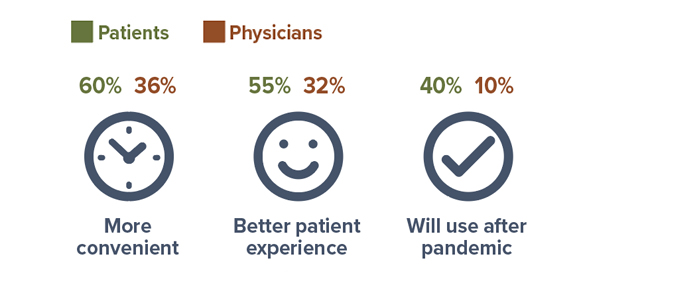Virtual Health Care Is Here to Stay
The use of telehealth skyrocketed early in the COVID-19 pandemic, with the number of remote office visits and outpatient services 78 times higher in April 2020 than in February 2020. Usage has stabilized since that extraordinary rise, but as of early 2021 remained 38 times higher than the pre-pandemic level.1

More recent data indicates that remote health care is here to stay. In August 2022, more than one out of five adults said they had an appointment with a health professional over video or phone during the previous four weeks.2
Remote Access
Telehealth encompasses a broad range of remote services including virtual office visits (also called telemedicine), remote patient monitoring, patient-physician communication through secure emails and websites, and online physician-to-physician consultation. Patients have immediate access to advice and treatment any time of the day or night, while avoiding unnecessary and costly emergency room visits. But telehealth is not only for emergency or off-hours situations; it also can be a more convenient and cost-effective way to get medical care that might normally be handled in a doctor’s office.
Telehealth can be used to treat minor problems such as allergies and rashes, or for an urgent condition such as a high fever. It makes it easier to access therapy for mental health issues such as depression and anxiety, and can fill gaps in the availability of specialty care. In other cases, doctors can remotely monitor the vital signs of patients with chronic conditions or follow up after a hospital discharge, and physical therapists can lead patients through exercises and monitor their progress.
Patient vs. Doctor Experience
Patients tend to rate telehealth more highly than physicians do.

Source: McKinsey & Company, 2022 (surveys conducted 2020–2021)
In 2021, 28% of large employers (500 or more employees) offered a virtual behavioral health-care network, 25% offered targeted virtual health solutions to address specific conditions such as diabetes and musculoskeletal problems, and 16% offered a virtual primary-care service or network. About 12% of eligible employees used a telemedicine service in the first half of 2021.3
Original Medicare and Medicare Advantage plans also cover a wide variety of telehealth services. Some of these were specifically added to coverage because of the pandemic and are scheduled to expire at the end of 2023.4 Considering the convenience and cost savings associated with telehealth, it is possible they will be extended, but that remains to be seen.
If your health plan includes telehealth services, you might take a closer look at the details, download the app, and/or register for an online account. You’ll be ready to log in quickly the next time you or someone in your family faces a medical problem.
1) McKinsey & Company, July 9, 2021
2) Centers for Disease Control and Prevention, 2022
3) Mercer, December 13, 2021
4) Centers for Medicare & Medicaid Services, January 2022
This information is not intended as tax, legal, investment, or retirement advice or recommendations, and it may not be relied on for the purpose of avoiding any federal tax penalties. You are encouraged to seek guidance from an independent tax or legal professional. The content is derived from sources believed to be accurate. Neither the information presented nor any opinion expressed constitutes a solicitation for the purchase or sale of any security. This material was written and prepared by Broadridge Advisor Solutions. © 2022 Broadridge Financial Solutions, Inc.
